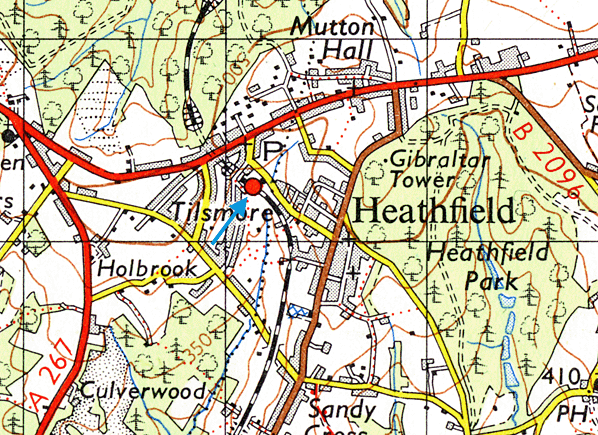
Station Name: HEATHFIELD (Sussex)
|
| Date opened: | 3.4.1880 |
| Location: | On the south side of Station Approach |
| Company on opening: | London Brighton & South Coast Railway |
| Date closed to passengers: | 14.6.1965 |
| Date closed completely: | 5.8.1968 |
| Company on closing: | British Railways (Southern Region) |
| Present state: | The station house the single storey street level booking office is now Steamer Trading Cookhouse and Cafe (company has now ceased trading) All trace of the platforms and goods yard have been cleared and the site is now an industrial estate. The Heathfield Tunnel to the north of the station has been restored as part of the proposed northern extension to the Cuckoo Trail. |
| County: | Sussex |
| OS Grid Ref: | TQ581213 |
| Date of visit: | June 1968, June 1975, May 1976, September 1982, May 1995 & May 2005 |
|
Notes: The country's first natural gas deposits were found at the entrance to Heathfield tunnel to the north of the station in 1895. The find was not exploited until the following year when the railway company drilling for water and smelt gas at 312 feet. A pressure of 140lbs. to the square inch was found to exist and it persisted for about six years. The railway quickly put the gas to good use by illuminating the station. In 1901 some Americans, under the name of 'The Natural Gas Fields of England Ltd.,' sank further bore holes, one reaching a depth of 400 feet. The output of one of these was recorded at 15 million cubic feet a day - equivalent in those days to one eighth of the total daily sale of gas in London. Due to its purity the gas was found to be of great value in research in aid of safety in mines and bottled supplies were taken. By 1934 the gas supply had run out for all practical purposes and the station lighting was converted to use ordinary town gas. Heathfield was one of the busiest stations on the line with the heaviest passenger traffic serving a wide area. It had a large goods depot which remained open until 5.8.1968 BRIEF HISTORY OF EASTBOURNE
- TUNBRIDGE WELLS (CUCKOO) LINE The remainder of the route northwards from Hailsham to Eridge was completed some 31 years. In 1873, local business interests promoted a Bill for a 3' gauge line from Tunbridge Wells to Polegate. Little progress was made in raising the required capital and the LBSC stepped in, obtaining an Act in 1876 giving them authority to extend their Hailsham line to Eridge where it joined the Uckfield - Groombridge Junction line (opened in 1868). The South Eastern Railway was to be given a share in the receipts and running powers over the line into Eastbourne. The 7 1/2 miles of single track was opened between Hailsham and Heathfield on 5th April 1880 and the 9 3/4 miles on to Eridge on 1st September that year. At Redgate Junction, south of Eridge it joined the route from Uckfield to Groombridge and both lines ran in parallel to Tunbridge Wells and to London via the Oxted line. When the Uckfield line was doubled in 1894 the Heathfield line north of Redgate Junction became the down line. The name `Cuckoo' was adopted by the railwaymen themselves. This relates to the old Sussex legend that on the 14th April annually the first cuckoo of summer is released at Heathfield Fair.
By 1925 the single track spur from Tunbridge Wells West to Central was little used with four daily trains to Brighton and two to Uckfield. Three of these carried through carriages for the Cuckoo line which were detached at Eridge. By the 1950's this had improved and in 1956, 58 passenger trains and two freights used the spur making it, for that year, the busiest section of single track in the country. The main goods stations on the Cuckoo line were at Heathfield and Hailsham, the other stations handled little more than the occasional wagon of coal. Despite a new timetable being introduced in the 1950's with
one train an hour on the Cuckoo line, it was not to survive
the Beeching cuts. In 1965 a survey revealed that there were
only 250 passengers a day using the line of which only 23 were
season ticket holders. Any attempt to promote the line was halted
under the Beeching plan and a new timetable was introduced with
long waits between connecting trains designed to deter passengers
from using the service. Although the line between Groombridge and Tunbridge Wells West was also proposed for closure this remained open but there was no future investment in the line and by the early 1980's the track and signaling needed replacing. With the planned removal of Grove Junction during the upgrade of the Tonbridge - Hastings line British Rail decided they could no longer justify keeping the line open and announced closure of the line from 16th May 1983. Once again there were strong objections but these were outweighed by British Rail's cost argument. They estimated that to upgrade the infrastructure, while retaining the existing services, would give a £175,000 loss per year and the Secretary of State confirmed closure of the line on 6th July 1985. Grove Junction was removed the day after closure but the line from Eridge to Tunbridge Wells remained in use until 10th August 1985 when the depot was closed. Shortly after closure the Tunbridge Wells and Eridge Railway Preservation Society was formed with an aim of reinstating the passenger service on the line. The Society acquired the line in the early 1990's and by winter 1996 they had refurbished half a mile of track and were able to run a steam service from their base on part of the old Tunbridge Wells West station site. TWERPS later merged with the North Downs Steam Railway at Dartford, Kent. The line is now known as The Spa Valley Railways, a name chosen as the result of a competition. The Spa Valley Railway now runs for 5 miles to a new station at Groombridge with an intermediate station at High Rocks built by the owner of the High Rocks Inn and Restaurant. Between 1992 - 1994 the section of line between Polegate and Heathfield was reopened by the county council as a footpath and cycleway known as the Cuckoo Trail. There are proposals to extend northwards from Heathfield and as part of this extension Heathfield Tunnel has been restored and lit and the 'Millennium Gates' fitted to the south portal. To see the other stations on the Eastbourne - Tunbridge Wells West line click on the station name: Tunbridge Wells West, High Rocks Halt, Groombridge, Eridge, Rotherfield & Mark Cross, Mayfield, Horam, Hellingly, Hailsham, Polegate, Hampden Park & Eastbourne |
old9.jpg)
Copyright photo by Terry Williams from Terry's Transport & Scenic Pics web site
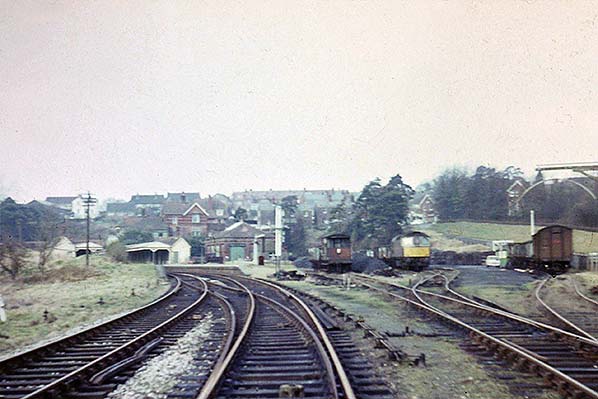
Photo by Brian Halford
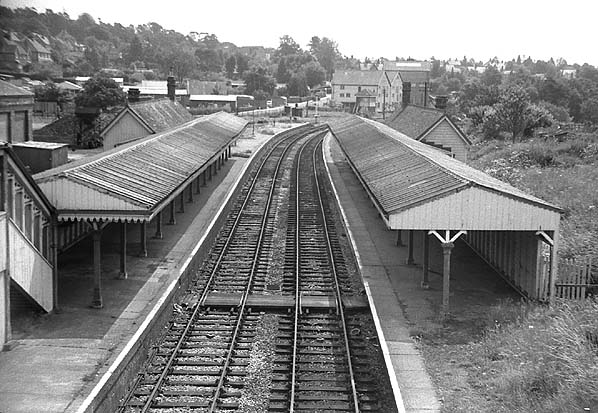
Photo by Nick Catford
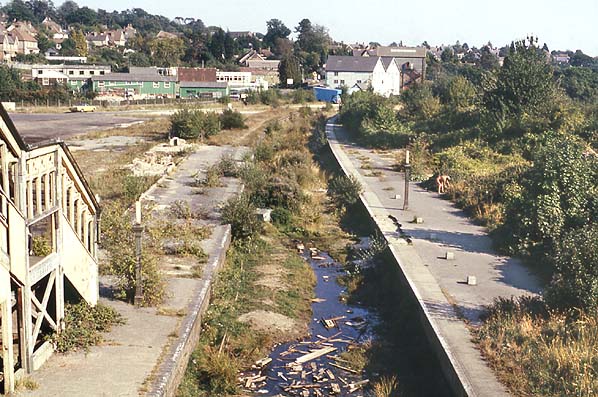
Heathfield Station
in May 1976
Photo by Nick Catford
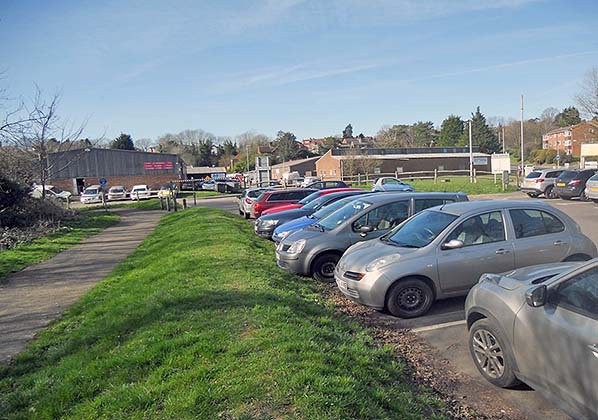
Looking north-west towards Heathfield station in 2017. The station platforms towards the left and the goods yard towards the right centre.
Photo Brian Halford
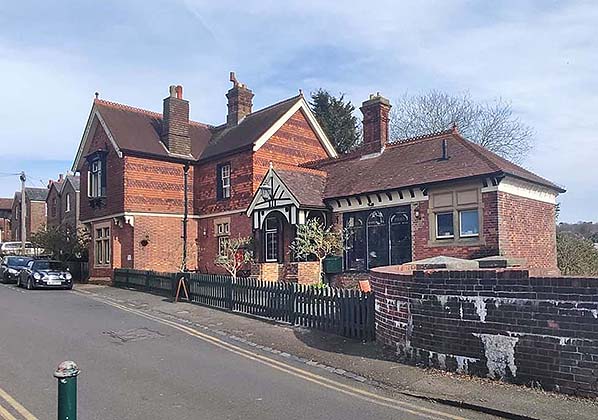 Heathfield
station station entrance and stationmaster's house in M
Heathfield
station station entrance and stationmaster's house in M
arch 2021. The booking office is a cafe.
Photo
by Nick Catford
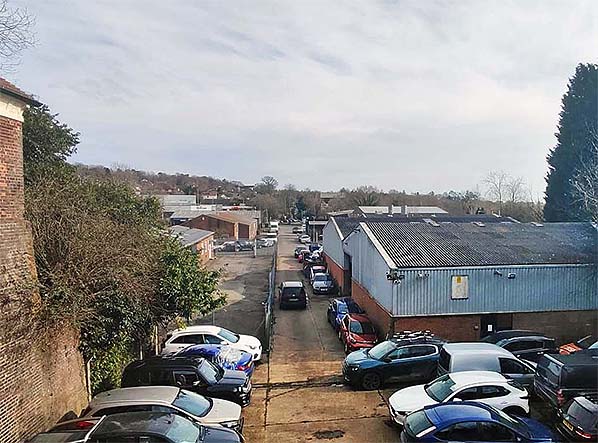
Looking south from Station Approach bridge in March 2019. The station and goods yard have been an industrial estate since the 1980s.
Photo by Nick Catford
Click here for more pictures of Heathfield Station
CLICK
HERE
FOR A FULL LIST OF LINES AND STATIONS SERVING
TUNBRIDGE WELLS WEST

|
 Home
Page
Home
Page
| Last updated: Wednesday, 30-Mar-2022 00:34:38 CEST |
© 1998-2005 Disused Stations |
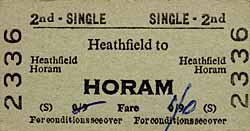
4.jpg)
